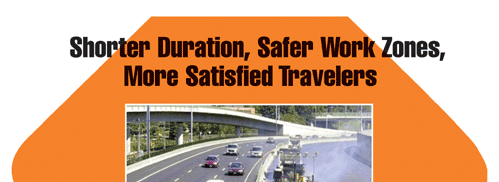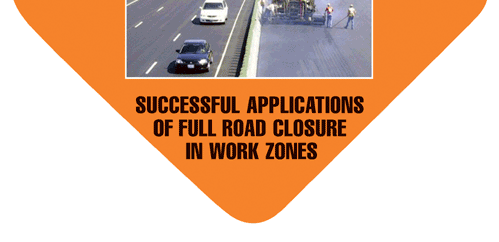

"Without a doubt, closing the freeways allowed us to complete the work in a short amount of time, resulting in increased efficiency and a better product." - Ernie Savas, Regional Engineer, Michigan Department of Transportation
This is just one testimonial from a forward-thinking transportation official whose agency uses Full Road Closure to reduce congestion and crashes in work zones. This method uses facility closure and total traffic diversion, which may be for one direction or bi-directional traffic flow, to accelerate construction and reduce the negative impacts of work zones. With good planning, interagency communication, and pro-active outreach to businesses and communities, full closure can be successful and well-received.
Potential benefits of using full closure in work zones include:
- Reduced project duration
- Increased worker productivity
- Improved safety
- Improved product quality
- Positive public sentiment
- Cost savings
![]()
The Kentucky Transportation Cabinet (KYTC) successfully used a full closure strategy to complete a major
rehabilitation project on I-65 near Louisville. The project was the state´s first use of a sustained full
closure. Originally estimated to take 90 days under part-width construction with maintenance of traffic, the
project only took 104 hours over two weekends under the full closure method. The use of full closure reduced
the exposure of the traveling public to the work zone, and impacts were reduced because the construction took
place during off-peak periods. With the success of the full closure, the KYTC decided to use full
closure on some future rehabilitation projects.

![]()
Full closure on the M-10 in Detroit, Michigan (Figure 1) allowed the project to be completed ahead of schedule.
Access to some popular destinations would be limited during construction, making project timing and acceleration critical.
The bi-directional full closure enabled MDOT to:
- Reduce standard maintenance of traffic cost by 75 to 90 percent
- Reduce project duration by 71 percent
- Allow for access to the Joe Louis Arena during hockey season
"M-10, the Lodge Freeway, is the main entrance to downtown Detroit. We chose to close an entire stretch of it in the downtown area in the summer of 2002 for reconstruction, opting to get it done quicker, at a lower cost, rather than spread the construction over two seasons. Travelers quickly found alternate routes, and the freeway reopened in two months, earlier than expected." - Maryann Mahaffey, President, Detroit City Council
![]()
The Oregon Department of Transportation (ODOT) used full closure to repave the busiest road in the state.
Rehabilitation on I-84 near Portland was originally scheduled for 2005, but the project schedule was moved up
because of the bad condition of the roadway and availability of funding. To finish the roadwork before the end
of the construction season, ODOT used two full closures (one direction at a time) to complete the project within
a 10-day span, instead of 32 nights of work using traditional part-width construction. The use of full closure:
- Reduced the overall cost of the project by $100,000; had the contract originally specified the use of full closure, ODOT engineers estimate that the total project cost of $2.5 million may have been cut in half
- Reduced project time from an estimated 320 hours to 112 hours
- Removed the traffic/work zone interaction, which reduced the exposure of traffic to work zones
![]()
I-95 through Delaware serves as a major artery connecting the Northeastern corridor with the Southern states.
A 12.1-mile section of I-95 was closed, one direction at a time over a 28-week period, to rehabilitate
the road. Using full closure:
- Improved public appreciation for Delaware DOT services
- Reduced project duration by 75 percent
- Removed the traffic/worker interaction, likely improving safety
- Increased transit use through outreach and service enhancements; this greater use continued after project completion
| |
||
 |
The Ohio Department of Transportation used full closure (Figure 2) during the rehabilitation of a major route through downtown Columbus, Ohio. The bi-directional reconstruction and widening project on I-670 is planned for completion in the fall of 2003, and is expected to save time and money, alleviate driver frustration, and potentially save lives. The use of full closure is expected to:
|
|
|
"Under the appropriate conditions, a full closure can be an effective way to complete projects faster and improve safety for highway workers and motorists." - Gordon Proctor, Director, Ohio Department of Transportation |
||
| More information on full closure in Work Zones may be found in Full Road Closure for Work Zone Operations: A Cross-Cutting Study |
 |
|
Federal Highway Administration
Work Zone Program
Room 3408, HOTO-1
400 Seventh St., SW
Washington, DC 20590
EDL#13794, FHWA-OP-03-086